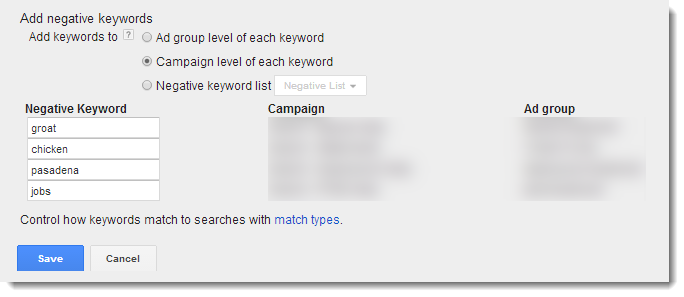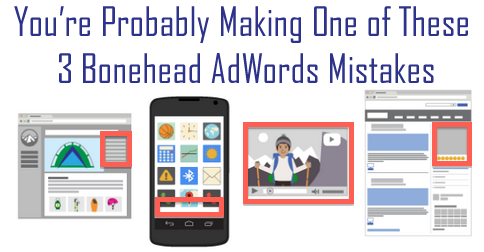Everybody makes mistakes. Having audited hundreds of AdWords accounts, I’ve seen plenty of PPC blunders.
Blindly accepting Search Query suggestions: we all know that examining search queries to find potential positive and negative keywords is a “best practice.” It’s easy to generate a Search Query report – when viewing keywords, just look under the Details drop-down.
AdWords “helps” you turn search terms into negative keywords – you just select the search terms and click on the “Add as a negative keywords” button.
You’ll see a dialog box showing the negative keywords, along with options to add them at the campaign or ad group level, or to a negative keyword list – like this one for a fictional San Francisco bakery:

So it usually makes sense to use Broad Match negative keywords instead, and often to shorten the suggestions so that AdWords will screen more search queries. For example:
Since the bakery doesn’t sell products made from groats or chicken, the two Broad Match keywords will ensure ads are never shown in response to any search queries that contain those words. Same idea for the latter two keywords. (In this example it’s a good idea to go back later and add the Broad Match negative keywords “groats” and “job.”)
Side note: frequently it makes better sense to apply the negative keywords at the Campaign level rather than at the Ad Group level. If that’s the case, make sure to change that option as shown in the second screen shot.
Using negative keywords in Google Display Network campaigns: It’s not unusual for advertisers to create keyword-targeted Display campaigns by duplicating Search campaigns or ad groups and just changing the network targeting. These are easy to spot because ad groups usually consist of long positive and negative keyword lists.
I’ve also seen plenty of Display campaigns with different targeting – topic, placement, and even remarketing – to which negative keywords have been added – usually the same negative keywords that have been used in the advertiser’s Search campaigns.
Why is this a mistake? Because negative keywords should almost never be used in Display campaigns. The reason is simple: For each negative keyword, the advertiser is telling AdWords, “Don’t display my ad on any pages that contain this word.” Many Display Network pages might be perfectly relevant to your company or product – while containing words in your negative keyword list.
Have you been frustrated when a Display Network ad group fails to “get traction” – accumulating a surprisingly small number of impressions and clicks? Check to see whether your campaigns or ad groups contain negative keywords. Usually it makes sense to simply delete (er… “remove”) ‘em all.
Displaying ads on shaky GDN sites: Unless you check your Automatic Placement reports verrry carefully, you might not realize your Google Display Network ads are often appearing on sites with relatively “undesireable” content. Do you want your ads appearing on sites with content that’s sexually suggestive, or “juvenile, gross and bizarre?” Do you think your ads will perform well on parked domains and error pages?
Very few GDN campaigns I’ve seen take advantage of a simple mechanism for keeping ads off whole categories of potentially-undesirable sites: Site Category Exclusion.
The feature sits at the bottom of the targeting page you see when you select an ad group’s big red “+ Targeting” button. You’ll see it under Campaign Exclusions after you click on the edit icon shown here:
So that’s it: the three bonehead mistakes I see most frequently. Are you such a PPC stud or stud-ette that you already knew about them all? Email me at david@fmbmedia.com and I’ll send you a free copy of my book.
David Szetela
Latest posts by David Szetela (see all)
- You’re Probably Making One of these 3 Bonehead AdWords Mistakes - August 21, 2014
